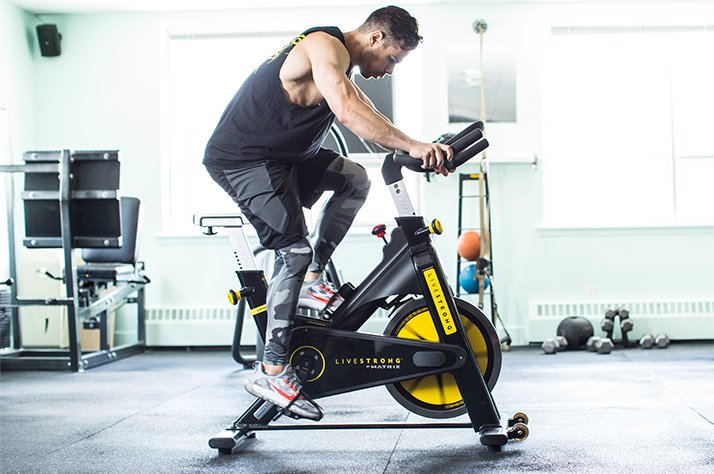
Strong And Lean: Your 4-Week Plateau-Busting Program
Need a program that will propel you out of a training slump and help you achieve your strength and physique goals? Try Alex Savva's 4-week plateau-busting training protocol!
It happens to every lifter: You're crushing your lifts and progressing nicely, surging through your workouts and netting great results, and then—bam! A plateau appears on your training landscape, and your progress stagnates. If you're stuck in this scenario, don't worry! I've been working on a training regimen that will push you past your limits and help you develop the strength and chiseled physique you've always wanted, plateau be damned.
This rut-busting program combines basic movements, high-intensity principles, circuits, and tempo training. When done with the correct intensity, it's brutally hard, but you'll be able to complete each workout in 30 minutes or less. Even better, you can expect some significant results in a short time period!
Results in One Month
This program works so well because it's built on high-intensity training principles. High-intensity exercise has been shown to stimulate lipolytic (fat-utilizing) hormones, including growth hormone and epinephrine, which promote greater post-exercise energy expenditure (also called excess post-exercise oxygen consumption, or EPOC) and fat burning.1

Along with training at a high intensity, you'll be doing high-volume, full-body lifts that will challenge every aspect of your fitness. Studies show that high-volume, whole-body resistance training significantly elevates resting energy expenditure up to 72 hours after exercise in both trained and untrained subjects.2,3
In other words, not only will you be getting stronger through resistance training, you'll burn through calories like a freak!
The reason each workout is so short is because I believe it's not how long you exercise, but how hard you go that determines the end result. This is the philosophy I follow in my own training, and it's exactly what I tell each of my clients.
To make the most of this program, all you need is the dedication to go hard.
The Freaky Details
Program structure
The structure here is simple: Move from one exercise to the next with no rest. That means you'll hit a set, take a drink of water, and get right back at it. When you finish an exercise, you'll jump right into the next one.
You'll be performing three workouts each week on Monday, Wednesday, and Friday. Mondays are chest and back workouts, Wednesdays are shoulder and arm workouts, and Fridays are leg days.
Cardio
I recommend that you mix in some cross-training/cardio days with your resistance-training days. I prefer high-intensity interval cardio, but you can perform whatever cardio or cross-training you like best. The only rule is that you perform at least two days of cross training or cardio per week.

Sets and reps
During each weight-training workout, you will perform 5 sets of 5 reps of one primary exercise per selected body part. After those primary exercises, you'll do 12-15 reps with lighter weight for isolation and core movements.
If you've never tried this type of training protocol before, I recommend you start your 5x5 exercises with loads at 75 percent of your 1-rep max. Once you can complete all reps and sets of a workout, increase the load by approximately 5 percent.
I've chosen these lower rep ranges for a good reason. Research shows that using low-to-intermediate repetitions (3-11 reps) during resistance-training programs induces a greater hypertrophic (muscle-building) effect and improves maximal strength significantly more than high-repetition (20 or more reps) work.4
Lifting tempo
Along with performing each set and rep with intensity, it's important to control all movements and follow the prescribed lifting tempo for each exercise. The lifting tempo used in this program is written in a sequence of four numbers, such as 6-0-6-0.
The first number represents the eccentric (lowering) phase, the second number represents the stretched (end of eccentric) phase, the third number represents the concentric (lifting) phase, and the fourth number represents the peak contracted phase. The number assigned to each phase of the tempo represents the number of seconds you should take to complete each phase.
Controlling the tempo of each lift will increase the time your muscles are under tension, which will amplify the amount of work your muscles have to do each rep. In order to perform these lifts well, you may have to use less weight than you would performing faster reps.
A recent study conducted at McMaster University showed that slower-tempo training with six-second concentric and eccentric phases elicited greater responses in mitochondrial and sarcoplasmic protein synthesis when compared to faster-tempo training with one-second concentric and eccentric phases.5 Another study showed that longer time under tension per set resulted in greater EPOC and energy expenditure.6
These scientific findings show that lifting tempo is an ultraimportant part of a good training regimen. Make sure you do the lifts exactly as I've programmed them!
Rest and Recovery
Although I've programmed work for every day of the week, if you need a day or two of complete rest per week, then take it. This program needs to work for your schedule and your goals. If you feel like you can sneak in more cardio and feel energized for your circuit workouts, then do it. But, if you're completely smoking yourself and your workouts suffer, you need to take more rest.
It's also important that you're sleeping at night. A recent study showed that 7-9 hours of quality sleep each night can help protect against the common cold. In fact, subjects who got less than seven hours of sleep were almost three times more likely to develop a cold compared to those who managed to get eight hours of sleep or more.7 It may not seem like a big deal, but wasting a week out of the gym or having to miss work due to a cold just plain sucks.
Start Today!
Now you have all the details you need to complete this program. Give me four weeks of hard, sincere effort, and I'll give you some incredible results! After these four weeks, you can start my #Freakmode 12-week fitness plan to build a plan that lasts 16 total weeks and will help you achieve your best-ever body and fitness level!
#FreakMode: Alex Savva's 12-Week Fitness Plan
The #FreakMode 12-week workout program will help you lose fat, build muscle, and learn the best ways to stay fit for life!
References
- Irving, B. A., Davis, C. K., Brock, D. W., Weltman, J. Y., Swift, D., Barrett, E. J., ... & Weltman, A. (2008). Effect of exercise training intensity on abdominal visceral fat and body composition. Medicine and Science in Sports and Exercise, 40(11), 1863.
- Schuenke, M. D., Mikat, R. P., & McBride, J. M. (2002). Effect of an acute period of resistance exercise on excess post-exercise oxygen consumption: implications for body mass management. European Journal of Applied Physiology, 86(5), 411-417.
- Hackney, K. J., Engels, H. J., & Gretebeck, R. J. (2008). Resting energy expenditure and delayed-onset muscle soreness after full-body resistance training with an eccentric concentration. The Journal of Strength & Conditioning Research, 22(5), 1602-1609.
- Campos, G. E., Luecke, T. J., Wendeln, H. K., Toma, K., Hagerman, F. C., Murray, T. F., ... & Staron, R. S. (2002). Muscular adaptations in response to three different resistance-training regimens: specificity of repetition maximum training zones. European Journal of Applied Physiology, 88(1-2), 50-60.
- Burd, N. A., Andrews, R. J., West, D. W., Little, J. P., Cochran, A. J., Hector, A. J., ... & Phillips, S. M. (2012). Muscle time under tension during resistance exercise stimulates differential muscle protein sub-fractional synthetic responses in men. The Journal of Physiology, 590(2), 351-362.
- Scott, C. B. (2012). The effect of time-under-tension and weight lifting cadence on aerobic, anaerobic, and recovery energy expenditures: 3 submaximal sets. Applied Physiology, Nutrition, and Metabolism, 37(2), 252-256.
- Cohen, S., Doyle, W. J., Alper, C. M., Janicki-Deverts, D., & Turner, R. B. (2009). Sleep habits and susceptibility to the common cold. Archives of Internal Medicine, 169(1), 62-67.




